Polynucleotides - Study guides, Class notes & Summaries
Looking for the best study guides, study notes and summaries about Polynucleotides? On this page you'll find 66 study documents about Polynucleotides.
Page 3 out of 66 results
Sort by
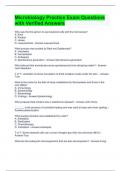
-
Microbiology Practice Exam Questions with Verified Answers
- Exam (elaborations) • 6 pages • 2024
- Available in package deal
-
- $10.49
- + learn more
Microbiology Practice Exam Questions with Verified Answers Atoms of the same element that have different numbers of neutrons are called_____. - Answer-isotopes If an element has two electrons in the first shell and seven in the second shell, the element is said to be what? - Answer-unstable The transfer of one or more electrons between interacting atoms results in what type of bond? - Answer-ionic bond The covalent bonding of atoms forms a/an _____ - Answer-molecule The _____ bond...
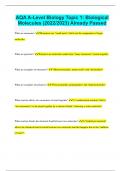
-
AQA A-Level Biology Topic 1: Biological Molecules (2022/2023) Already Passed
- Exam (elaborations) • 25 pages • 2024
- Available in package deal
-
- $8.99
- + learn more
What are monomers? Monomers are *small units* which are the components of larger molecules. What are polymers? Polymers are molecules made from *many monomers* joined together. What are examples of monomers? *Monosaccharides, amino acids* and *nucleotides* What are examples of polymers? *Polysaccharides, polypeptides* and *polynucleotides* What reaction allows two monomers to bond together? A *condensation reaction* allows *two monomers* to be joined together by a chemical bond, *releasing...
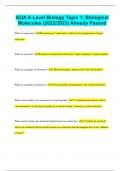
-
AQA A-Level Biology Topic 1: Biological Molecules (2022/2023) Already Passed
- Exam (elaborations) • 25 pages • 2024
- Available in package deal
-
- $8.99
- + learn more
What are monomers? Monomers are *small units* which are the components of larger molecules. What are polymers? Polymers are molecules made from *many monomers* joined together. What are examples of monomers? *Monosaccharides, amino acids* and *nucleotides* What are examples of polymers? *Polysaccharides, polypeptides* and *polynucleotides* What reaction allows two monomers to bond together? A *condensation reaction* allows *two monomers* to be joined together by a chemical bond, *releasing...
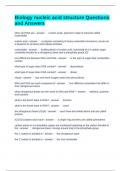
-
Biology nucleic acid structure Questions and Answers
- Exam (elaborations) • 5 pages • 2024
- Available in package deal
-
- $13.49
- + learn more
Biology nucleic acid structure Questions and Answers DNA and RNA are nucleic acids, polymers made of subunits called nucleotides nucleic acid a polymer consisting of many nucleotide monomers; serves as a blueprint for proteins and cellular activities 0:12 / 0:30 nucleotides building block of nucleic acid, consisting of a 5 carbon sugar covalently bonded to a nitrogenous base and a phosphate group (G) one difference between RNA and DNA is the type of sugar their nuc...
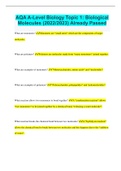
-
AQA A-Level Biology Topic 1: Biological Molecules (2022/2023) Already Passed
- Exam (elaborations) • 25 pages • 2023
- Available in package deal
-
- $9.99
- + learn more
AQA A-Level Biology Topic 1: Biological Molecules (2022/2023) Already Passed What are monomers? Monomers are *small units* which are the components of larger molecules. What are polymers? Polymers are molecules made from *many monomers* joined together. What are examples of monomers? *Monosaccharides, amino acids* and *nucleotides* What are examples of polymers? *Polysaccharides, polypeptides* and *polynucleotides* What reaction allows two monomers to bond together? A *condensation reaction*...
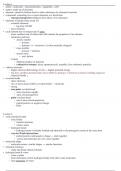
-
MCDB 6 midterm 1 review study guide biology
- Class notes • 5 pages • 2023
- Available in package deal
-
- $3.99
- 1x sold
- + learn more
This document is about the course MCDB 6 midterm 1 study guide.
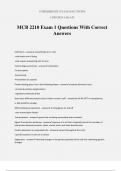
-
MCB 2210 Exam 1 Questions With Correct Answers
- Exam (elaborations) • 19 pages • 2024
-
- $11.49
- + learn more
MCB 2210 Exam 1 Questions With Correct Answers Cell theory - answer-everything has 1+ cells -cells=basic unit of living -cells require preexisting cells to arise Central dogma processes - answer1-activation 2-transcription 3-processing 4-translation (in cytosol) Protein folding gives rise to the following shapes - answer-enzymes (chemical rxns) -structural proteins (organization) -regulatory molecules (info) How many different proteins does it take to make a cell? - answerp-1K-4K (47...
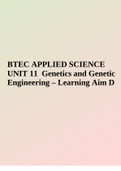
-
BTEC APPLIED SCIENCE UNIT 11 Genetics and Genetic Engineering – Learning Aim D
- Exam (elaborations) • 17 pages • 2023
-
- $15.99
- + learn more
BTEC APPLIED SCIENCE UNIT 11 Genetics and Genetic Engineering – Learning Aim D. A phosphate group, a sugar, and a base are the three components of a nucleotide. (“What are the three components of a nucleotide - B”) They are sugars and bases that make up DNA and RNA. An organic molecule is referred to as a base. Purines and pyrimidines are the two types of bases. Purines are adenine and guanine, while pyrimidines are thymine, uracil, and cytosine. (“Expand ATP class 12 biology CBSE”...

-
Test Bank for Cell and Molecular Biology Concepts and Experiments 8th Edition Karp | Complete A ll Chapters 2024/2025
- Exam (elaborations) • 122 pages • 2024
-
- $30.49
- + learn more
Which of the groups below is capable of only hydrophobic interactions? a) A b) B c) C d) D e) E Answer: e Difficulty: Medium Learning Objective: LO 2.3 Describe the role of noncovalent bonds in the structure of molecules such as water. Section Reference: Section 2.3 Noncovalent Bonds 2) Which of the following groups is capable of only hydrophilic interactions? d. H H C C C H H H H e.. H a.. OH b. C C C C C H H SH H H H H H H H H CH C C H H H H H NH 2 c.. C CH3 CH2 ...
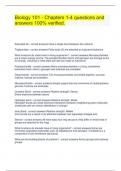
-
Biology 101 - Chapters 1-4 questions and answers 100% verified.
- Exam (elaborations) • 7 pages • 2024
- Available in package deal
-
- $10.99
- + learn more
Biology 101 - Chapters 1-4 questions and answers 100% verified. Saturated fat - correct answers.Have a single bond between the carbons Triglycerides - correct answers.Fatty acids (3) are attached to a glycerol backbone What functions do carbs have in living organisms? - correct answers.Monosaccharides are a major energy source. The polysaccharides starch and glycogen are storage forms for energy. Cellulose is what plant cell wall are made of (structure) Polysaccharide - cor...

Study stress? For sellers on Stuvia, these are actually golden times. KA-CHING! Earn from your study resources too and start uploading now. Discover all about earning on Stuvia


